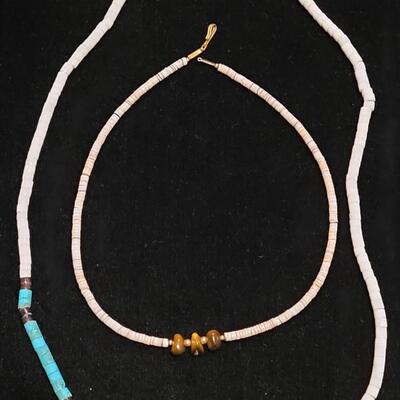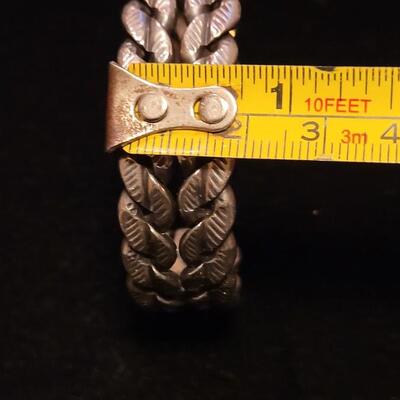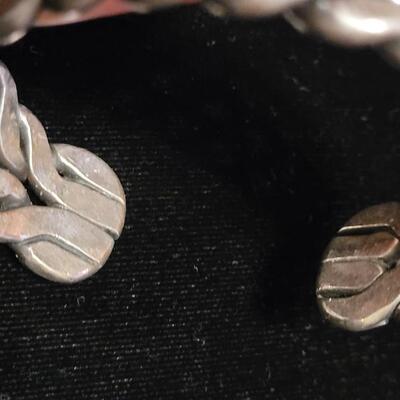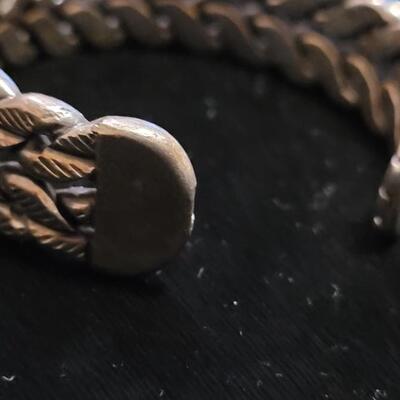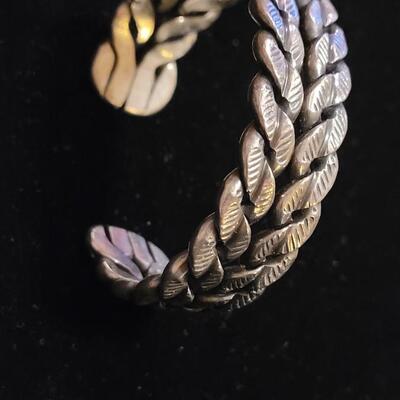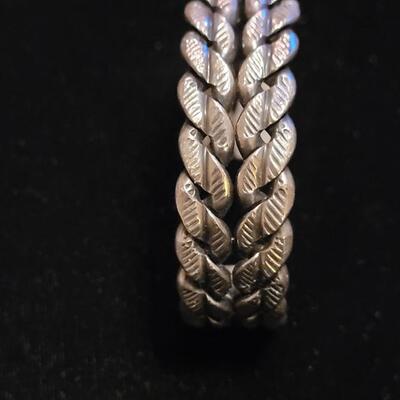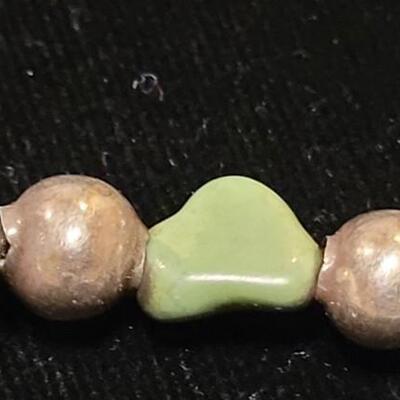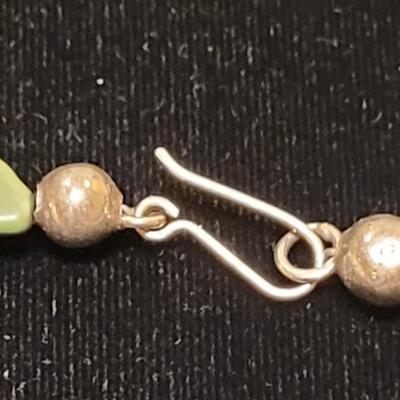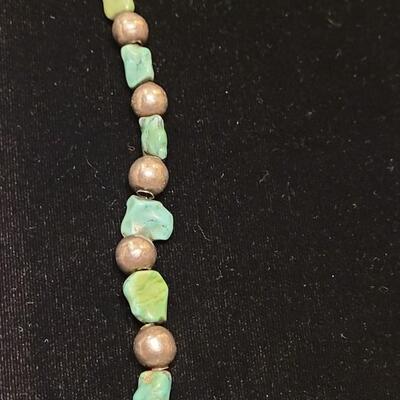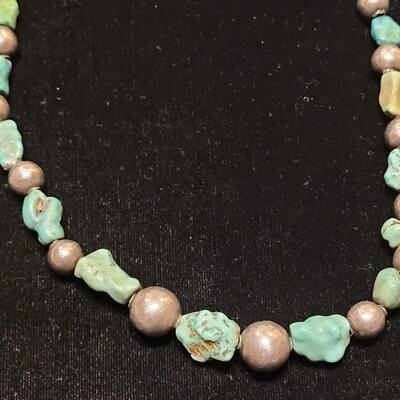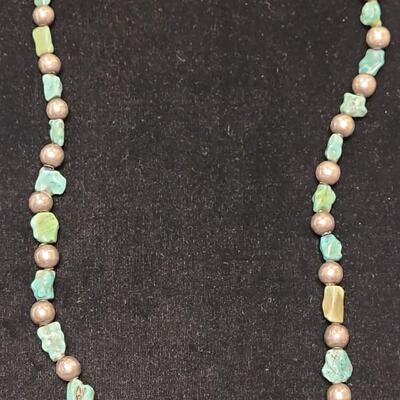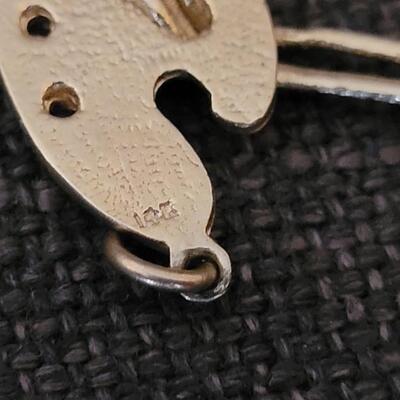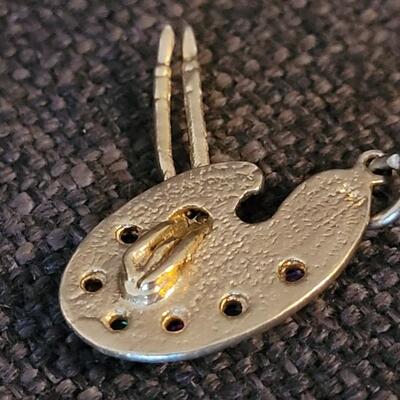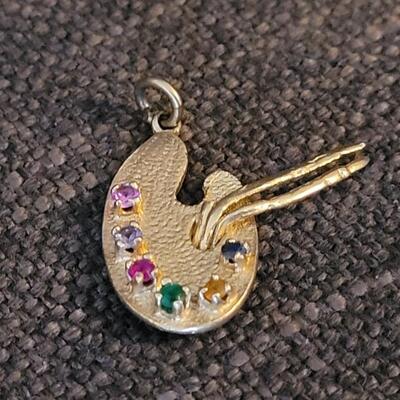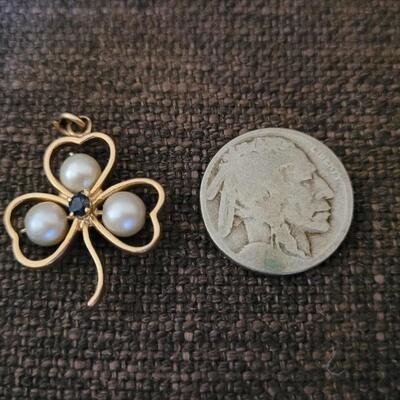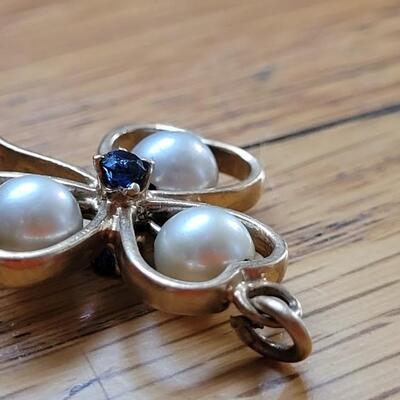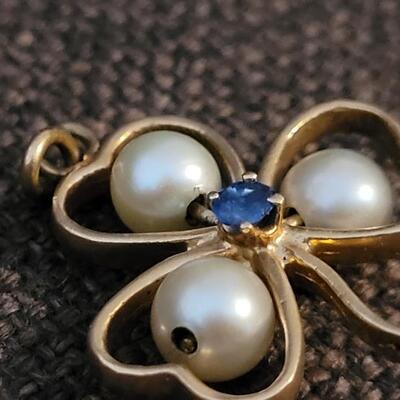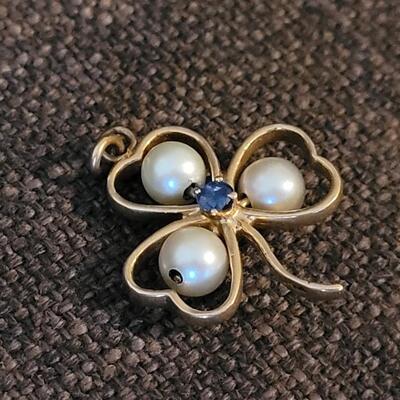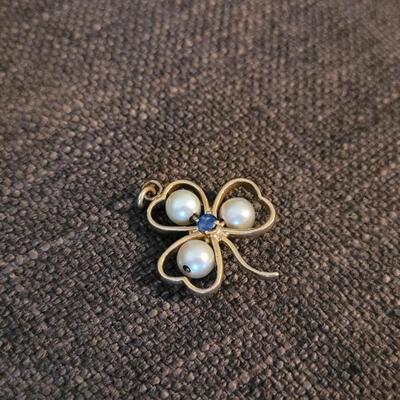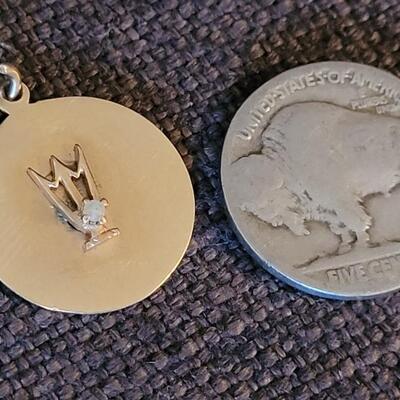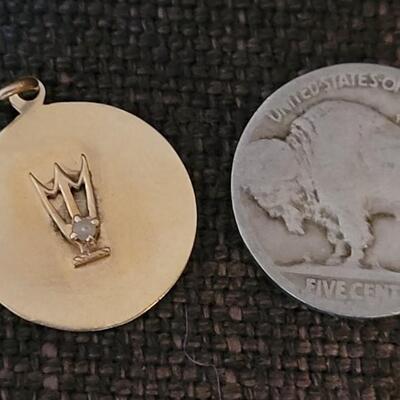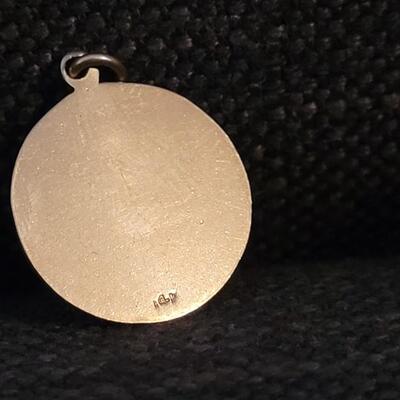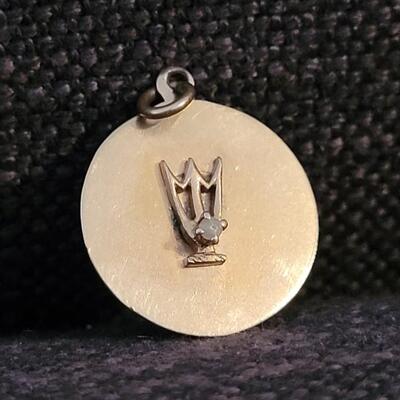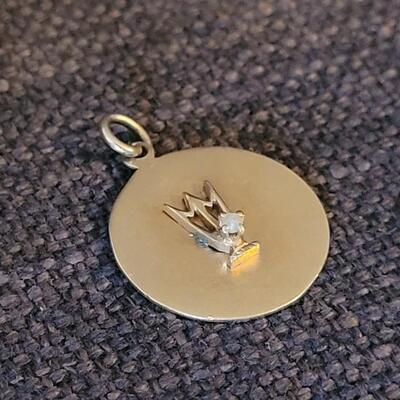-
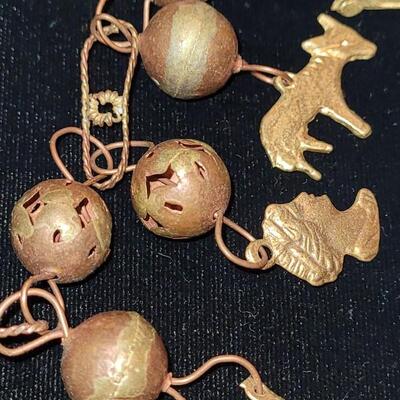
30.5" long See photos for Milagros insight. 1302 / 2223 sold -
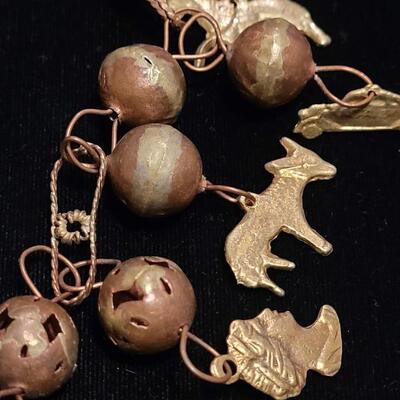
30.5" long See photos for Milagros insight. 1303 / 2223 sold -
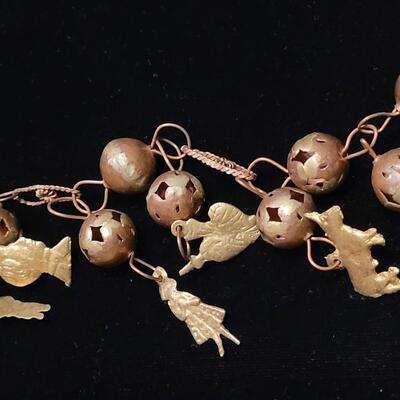
30.5" long See photos for Milagros insight. 1304 / 2223 sold -
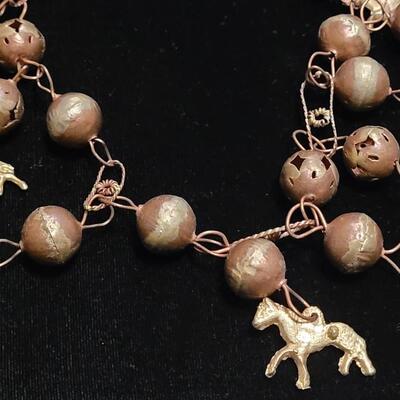
30.5" long See photos for Milagros insight. 1305 / 2223 sold -
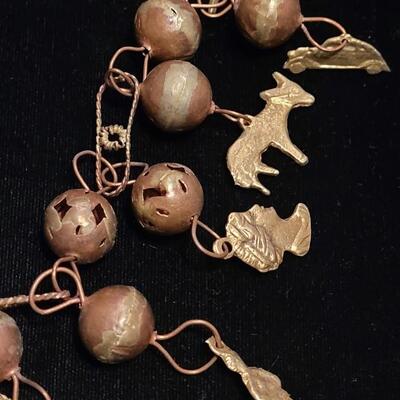
30.5" long See photos for Milagros insight. 1306 / 2223 sold -

30.5" long See photos for Milagros insight. 1307 / 2223 sold -
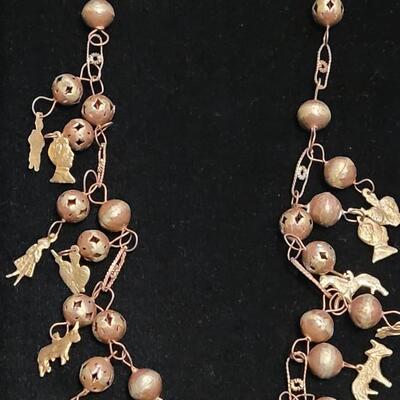
30.5" long See photos for Milagros insight. 1308 / 2223 sold -
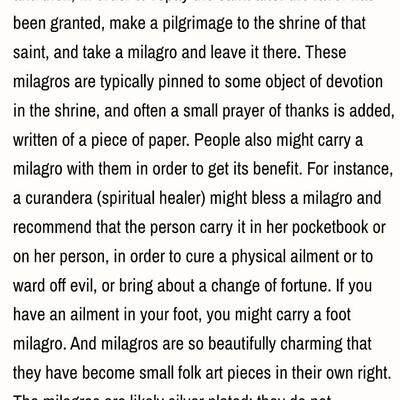
30.5" long See photos for Milagros insight. 1309 / 2223 sold -
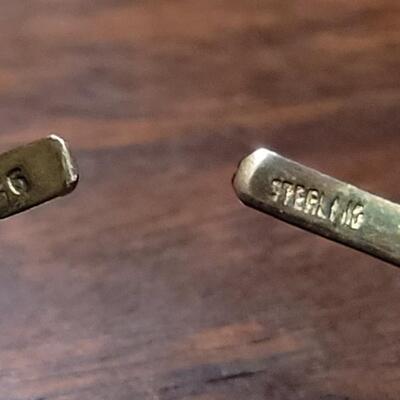
Only one is marked Taxco 1310 / 2223 sold -

Only one is marked Taxco 1311 / 2223 sold -
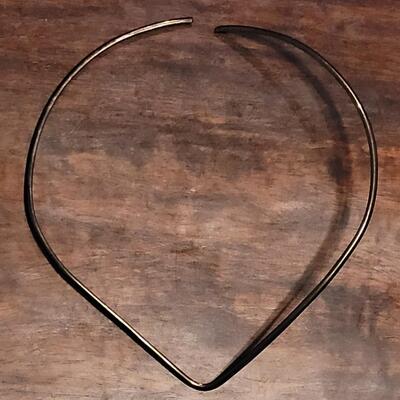
Only one is marked Taxco 1312 / 2223 sold -
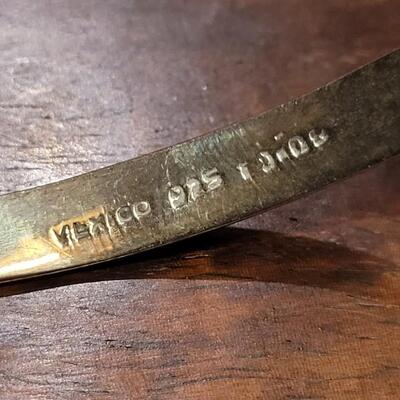
Only one is marked Taxco 1313 / 2223 sold -
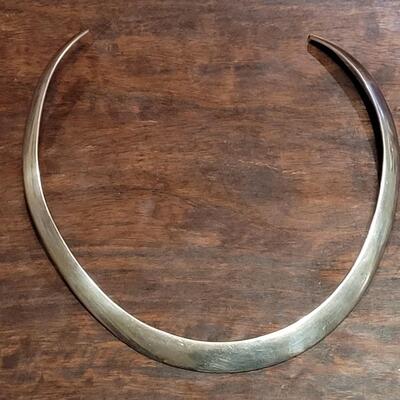
Only one is marked Taxco 1314 / 2223 sold -

Only one is marked Taxco 1315 / 2223 sold -
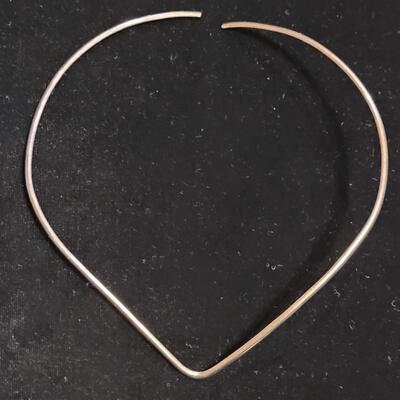
Only one is marked Taxco 1316 / 2223 sold -
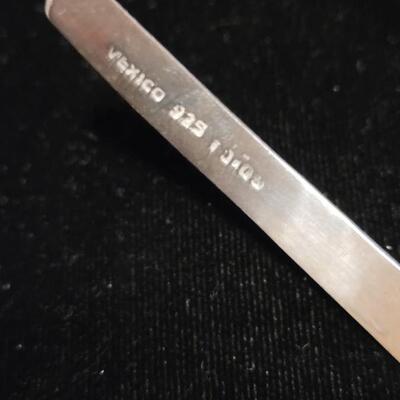
Only one is marked Taxco 1317 / 2223 sold -
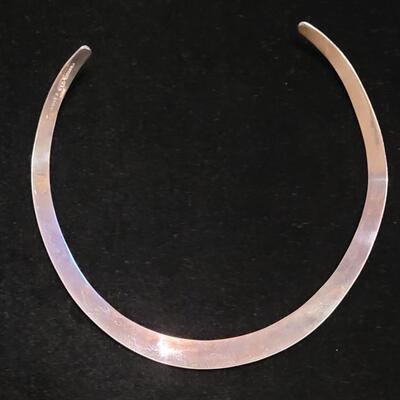
Only one is marked Taxco 1318 / 2223 sold -
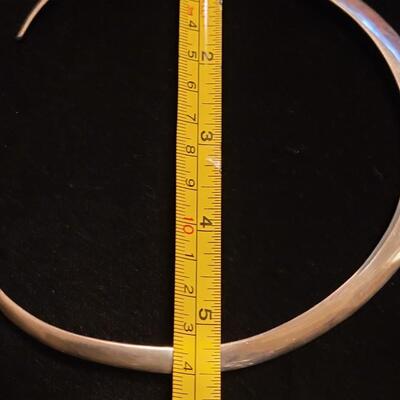
Only one is marked Taxco 1319 / 2223 sold -

Only one is marked Taxco 1320 / 2223 sold -

Only one is marked Taxco 1321 / 2223 sold -
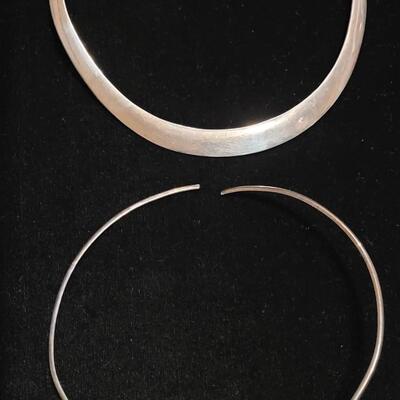
Only one is marked Taxco 1322 / 2223 sold -

30" long 1332 / 2223 sold -
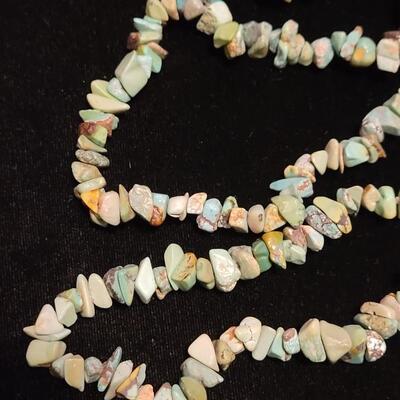
30" long 1333 / 2223 sold -

30" long 1334 / 2223 sold -

30" long 1335 / 2223 sold -

16" long EXCERPT: There are thousands of Mexican smiths who's work is known but who's names remain unknown. Up until the 1970's, record keeping, in Mexico's assay offices, was a pretty spotty affair. Most of the names we know today are because the makers became well known during their productive years, due to the high quality of their designs and better craftsmanship in their workshops. Of course, there are plenty of great pieces by unknown Mexican smiths and you may well have one here. I've handled a fair amount of their pieces and know that "AE in M" has produced some pretty good work. The mark is sometimes referred to as AE in a heart, but after you've seen various stampings of it, it becomes clearer as an M. Here's what I can tell you about them. The mark is usually seen in conjunction with Eagle #23, so they were producing between 1948 and the mid to late 1960's. Apparently they were fairly successful, having purchased and registered there own eagle number rather than using the generic #3 of the Taxco assay office. 1336 / 2223 sold -
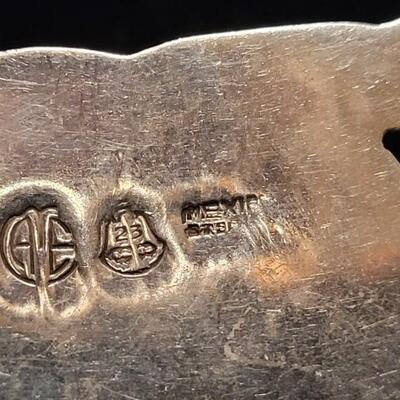
16" long EXCERPT: There are thousands of Mexican smiths who's work is known but who's names remain unknown. Up until the 1970's, record keeping, in Mexico's assay offices, was a pretty spotty affair. Most of the names we know today are because the makers became well known during their productive years, due to the high quality of their designs and better craftsmanship in their workshops. Of course, there are plenty of great pieces by unknown Mexican smiths and you may well have one here. I've handled a fair amount of their pieces and know that "AE in M" has produced some pretty good work. The mark is sometimes referred to as AE in a heart, but after you've seen various stampings of it, it becomes clearer as an M. Here's what I can tell you about them. The mark is usually seen in conjunction with Eagle #23, so they were producing between 1948 and the mid to late 1960's. Apparently they were fairly successful, having purchased and registered there own eagle number rather than using the generic #3 of the Taxco assay office. 1337 / 2223 sold -
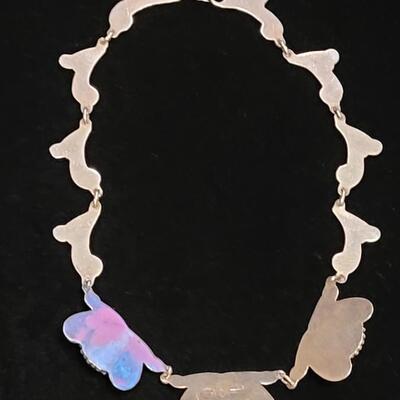
16" long EXCERPT: There are thousands of Mexican smiths who's work is known but who's names remain unknown. Up until the 1970's, record keeping, in Mexico's assay offices, was a pretty spotty affair. Most of the names we know today are because the makers became well known during their productive years, due to the high quality of their designs and better craftsmanship in their workshops. Of course, there are plenty of great pieces by unknown Mexican smiths and you may well have one here. I've handled a fair amount of their pieces and know that "AE in M" has produced some pretty good work. The mark is sometimes referred to as AE in a heart, but after you've seen various stampings of it, it becomes clearer as an M. Here's what I can tell you about them. The mark is usually seen in conjunction with Eagle #23, so they were producing between 1948 and the mid to late 1960's. Apparently they were fairly successful, having purchased and registered there own eagle number rather than using the generic #3 of the Taxco assay office. 1338 / 2223 sold -
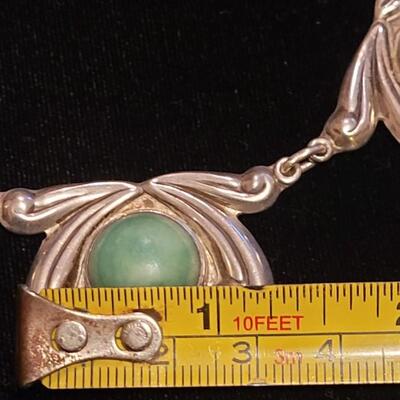
16" long EXCERPT: There are thousands of Mexican smiths who's work is known but who's names remain unknown. Up until the 1970's, record keeping, in Mexico's assay offices, was a pretty spotty affair. Most of the names we know today are because the makers became well known during their productive years, due to the high quality of their designs and better craftsmanship in their workshops. Of course, there are plenty of great pieces by unknown Mexican smiths and you may well have one here. I've handled a fair amount of their pieces and know that "AE in M" has produced some pretty good work. The mark is sometimes referred to as AE in a heart, but after you've seen various stampings of it, it becomes clearer as an M. Here's what I can tell you about them. The mark is usually seen in conjunction with Eagle #23, so they were producing between 1948 and the mid to late 1960's. Apparently they were fairly successful, having purchased and registered there own eagle number rather than using the generic #3 of the Taxco assay office. 1339 / 2223 sold -
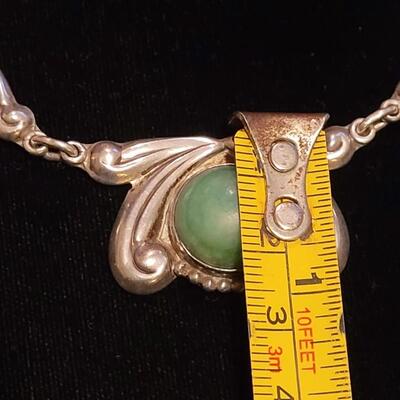
16" long EXCERPT: There are thousands of Mexican smiths who's work is known but who's names remain unknown. Up until the 1970's, record keeping, in Mexico's assay offices, was a pretty spotty affair. Most of the names we know today are because the makers became well known during their productive years, due to the high quality of their designs and better craftsmanship in their workshops. Of course, there are plenty of great pieces by unknown Mexican smiths and you may well have one here. I've handled a fair amount of their pieces and know that "AE in M" has produced some pretty good work. The mark is sometimes referred to as AE in a heart, but after you've seen various stampings of it, it becomes clearer as an M. Here's what I can tell you about them. The mark is usually seen in conjunction with Eagle #23, so they were producing between 1948 and the mid to late 1960's. Apparently they were fairly successful, having purchased and registered there own eagle number rather than using the generic #3 of the Taxco assay office. 1340 / 2223 sold -
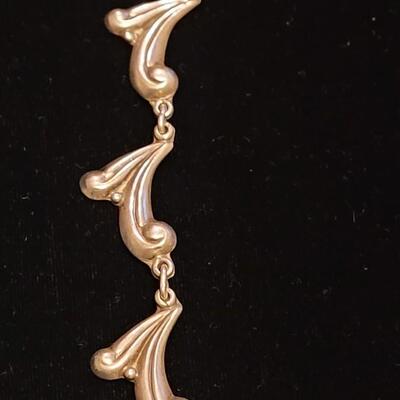
16" long EXCERPT: There are thousands of Mexican smiths who's work is known but who's names remain unknown. Up until the 1970's, record keeping, in Mexico's assay offices, was a pretty spotty affair. Most of the names we know today are because the makers became well known during their productive years, due to the high quality of their designs and better craftsmanship in their workshops. Of course, there are plenty of great pieces by unknown Mexican smiths and you may well have one here. I've handled a fair amount of their pieces and know that "AE in M" has produced some pretty good work. The mark is sometimes referred to as AE in a heart, but after you've seen various stampings of it, it becomes clearer as an M. Here's what I can tell you about them. The mark is usually seen in conjunction with Eagle #23, so they were producing between 1948 and the mid to late 1960's. Apparently they were fairly successful, having purchased and registered there own eagle number rather than using the generic #3 of the Taxco assay office. 1341 / 2223 sold -
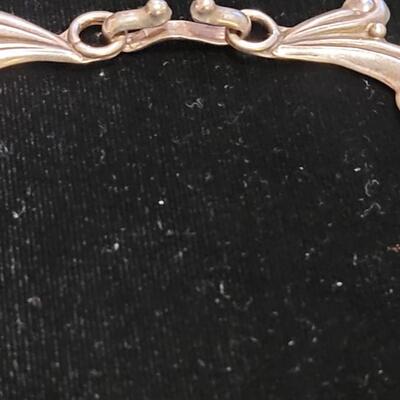
16" long EXCERPT: There are thousands of Mexican smiths who's work is known but who's names remain unknown. Up until the 1970's, record keeping, in Mexico's assay offices, was a pretty spotty affair. Most of the names we know today are because the makers became well known during their productive years, due to the high quality of their designs and better craftsmanship in their workshops. Of course, there are plenty of great pieces by unknown Mexican smiths and you may well have one here. I've handled a fair amount of their pieces and know that "AE in M" has produced some pretty good work. The mark is sometimes referred to as AE in a heart, but after you've seen various stampings of it, it becomes clearer as an M. Here's what I can tell you about them. The mark is usually seen in conjunction with Eagle #23, so they were producing between 1948 and the mid to late 1960's. Apparently they were fairly successful, having purchased and registered there own eagle number rather than using the generic #3 of the Taxco assay office. 1342 / 2223 sold -
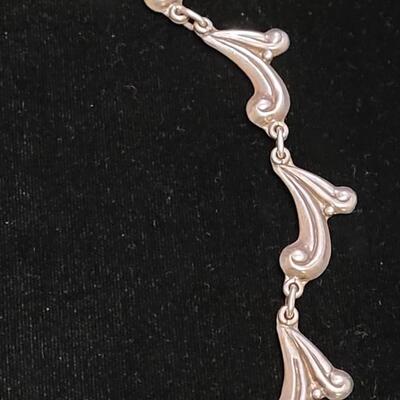
16" long EXCERPT: There are thousands of Mexican smiths who's work is known but who's names remain unknown. Up until the 1970's, record keeping, in Mexico's assay offices, was a pretty spotty affair. Most of the names we know today are because the makers became well known during their productive years, due to the high quality of their designs and better craftsmanship in their workshops. Of course, there are plenty of great pieces by unknown Mexican smiths and you may well have one here. I've handled a fair amount of their pieces and know that "AE in M" has produced some pretty good work. The mark is sometimes referred to as AE in a heart, but after you've seen various stampings of it, it becomes clearer as an M. Here's what I can tell you about them. The mark is usually seen in conjunction with Eagle #23, so they were producing between 1948 and the mid to late 1960's. Apparently they were fairly successful, having purchased and registered there own eagle number rather than using the generic #3 of the Taxco assay office. 1343 / 2223 sold -
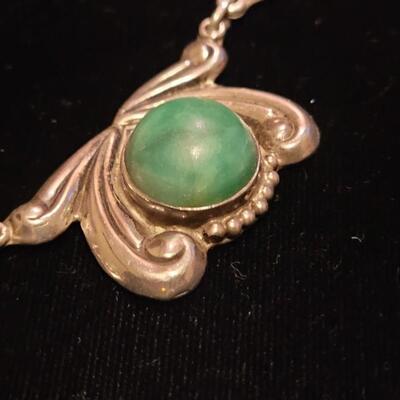
16" long EXCERPT: There are thousands of Mexican smiths who's work is known but who's names remain unknown. Up until the 1970's, record keeping, in Mexico's assay offices, was a pretty spotty affair. Most of the names we know today are because the makers became well known during their productive years, due to the high quality of their designs and better craftsmanship in their workshops. Of course, there are plenty of great pieces by unknown Mexican smiths and you may well have one here. I've handled a fair amount of their pieces and know that "AE in M" has produced some pretty good work. The mark is sometimes referred to as AE in a heart, but after you've seen various stampings of it, it becomes clearer as an M. Here's what I can tell you about them. The mark is usually seen in conjunction with Eagle #23, so they were producing between 1948 and the mid to late 1960's. Apparently they were fairly successful, having purchased and registered there own eagle number rather than using the generic #3 of the Taxco assay office. 1344 / 2223 sold -

16" long EXCERPT: There are thousands of Mexican smiths who's work is known but who's names remain unknown. Up until the 1970's, record keeping, in Mexico's assay offices, was a pretty spotty affair. Most of the names we know today are because the makers became well known during their productive years, due to the high quality of their designs and better craftsmanship in their workshops. Of course, there are plenty of great pieces by unknown Mexican smiths and you may well have one here. I've handled a fair amount of their pieces and know that "AE in M" has produced some pretty good work. The mark is sometimes referred to as AE in a heart, but after you've seen various stampings of it, it becomes clearer as an M. Here's what I can tell you about them. The mark is usually seen in conjunction with Eagle #23, so they were producing between 1948 and the mid to late 1960's. Apparently they were fairly successful, having purchased and registered there own eagle number rather than using the generic #3 of the Taxco assay office. 1345 / 2223 sold -

16" long EXCERPT: There are thousands of Mexican smiths who's work is known but who's names remain unknown. Up until the 1970's, record keeping, in Mexico's assay offices, was a pretty spotty affair. Most of the names we know today are because the makers became well known during their productive years, due to the high quality of their designs and better craftsmanship in their workshops. Of course, there are plenty of great pieces by unknown Mexican smiths and you may well have one here. I've handled a fair amount of their pieces and know that "AE in M" has produced some pretty good work. The mark is sometimes referred to as AE in a heart, but after you've seen various stampings of it, it becomes clearer as an M. Here's what I can tell you about them. The mark is usually seen in conjunction with Eagle #23, so they were producing between 1948 and the mid to late 1960's. Apparently they were fairly successful, having purchased and registered there own eagle number rather than using the generic #3 of the Taxco assay office. 1346 / 2223 sold -
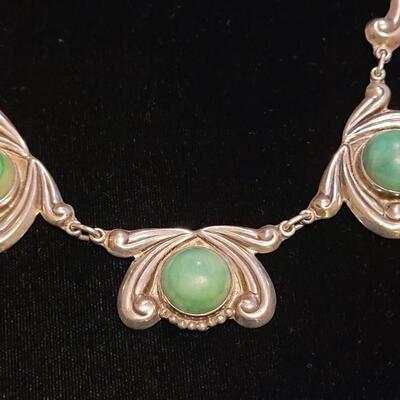
16" long EXCERPT: There are thousands of Mexican smiths who's work is known but who's names remain unknown. Up until the 1970's, record keeping, in Mexico's assay offices, was a pretty spotty affair. Most of the names we know today are because the makers became well known during their productive years, due to the high quality of their designs and better craftsmanship in their workshops. Of course, there are plenty of great pieces by unknown Mexican smiths and you may well have one here. I've handled a fair amount of their pieces and know that "AE in M" has produced some pretty good work. The mark is sometimes referred to as AE in a heart, but after you've seen various stampings of it, it becomes clearer as an M. Here's what I can tell you about them. The mark is usually seen in conjunction with Eagle #23, so they were producing between 1948 and the mid to late 1960's. Apparently they were fairly successful, having purchased and registered there own eagle number rather than using the generic #3 of the Taxco assay office. 1347 / 2223 sold -
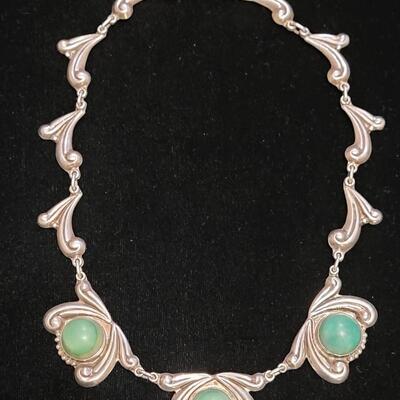
16" long EXCERPT: There are thousands of Mexican smiths who's work is known but who's names remain unknown. Up until the 1970's, record keeping, in Mexico's assay offices, was a pretty spotty affair. Most of the names we know today are because the makers became well known during their productive years, due to the high quality of their designs and better craftsmanship in their workshops. Of course, there are plenty of great pieces by unknown Mexican smiths and you may well have one here. I've handled a fair amount of their pieces and know that "AE in M" has produced some pretty good work. The mark is sometimes referred to as AE in a heart, but after you've seen various stampings of it, it becomes clearer as an M. Here's what I can tell you about them. The mark is usually seen in conjunction with Eagle #23, so they were producing between 1948 and the mid to late 1960's. Apparently they were fairly successful, having purchased and registered there own eagle number rather than using the generic #3 of the Taxco assay office. 1348 / 2223 sold -

Marked HS This makes is an unknown maker. 1349 / 2223 sold -

Marked HS This makes is an unknown maker. 1350 / 2223 sold -
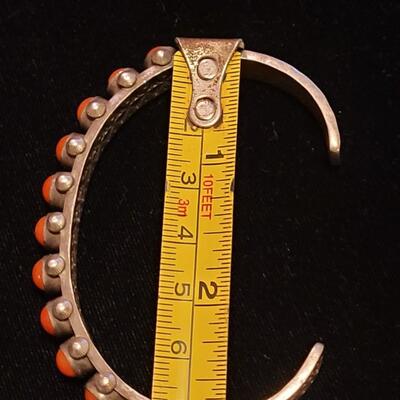
Marked HS This makes is an unknown maker. 1351 / 2223 sold -
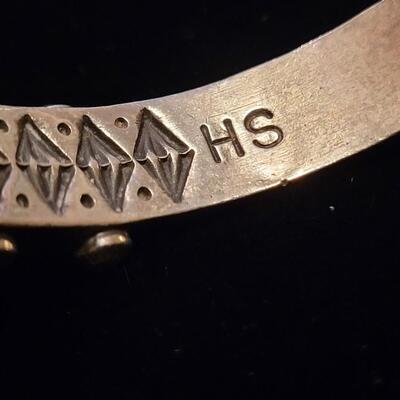
Marked HS This makes is an unknown maker. 1352 / 2223 sold -
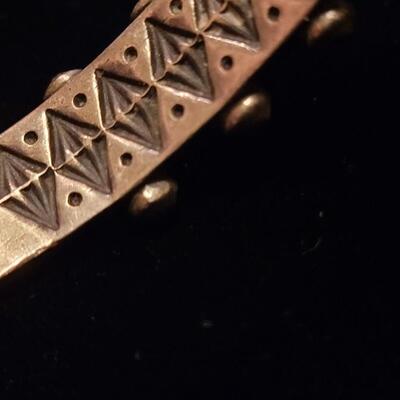
Marked HS This makes is an unknown maker. 1353 / 2223 sold -

Marked HS This makes is an unknown maker. 1354 / 2223 sold -
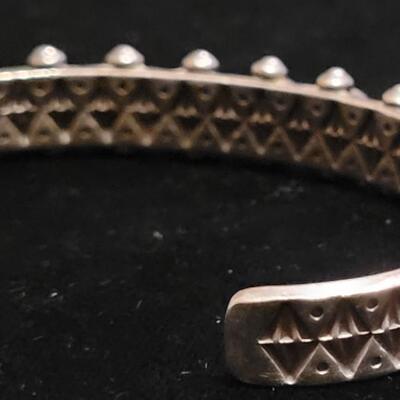
Marked HS This makes is an unknown maker. 1355 / 2223 sold -
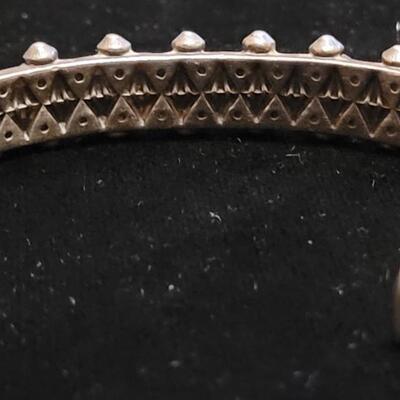
Marked HS This makes is an unknown maker. 1356 / 2223 sold -
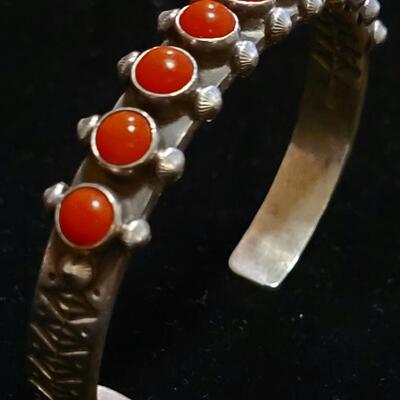
Marked HS This makes is an unknown maker. 1357 / 2223 sold -
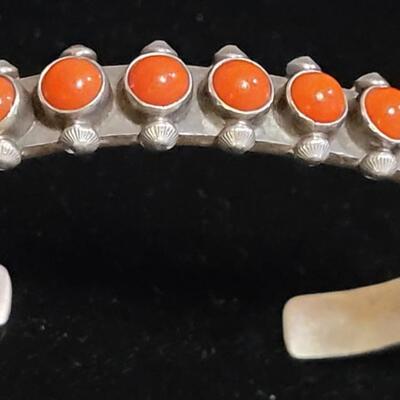
Marked HS This makes is an unknown maker. 1358 / 2223 sold -

Marked HS This makes is an unknown maker. 1359 / 2223 sold -

Marked HS This makes is an unknown maker. 1360 / 2223 sold -

76.5" × 53" Has damage throughout but still has a lot of life left. Excerpt about the Whirling Log: The swastika motif goes back thousands of years in human culture. One of the oldest symbols made by humans, the swastika dates back some 6,000 years to rock and cave paintings. Scholars generally agree it originated in India. In the Navajo culture the swastika or Whirling Log, represents well being, good luck and protection. It comes from tale of the Whirling Log. The Whirling Log The hero of the story sets out on a long journey. At first the gods try to persuade him against going, but seeing his determination, help him hollow out a log in which he will travel down the river. Along the way he has many misadventures which ultimately result in his gaining important ceremonial knowledge. In one such instance he and his craft are captured by the Water People who carry him down beneath the waters to the home of Water Monster. Black God threatens to set fire to Water Monster's home and the hero is released, but not before being taught by Frog how to cure the illnesses caused by the Water People. When he finally reaches the lake that is his destination, the gods catch his log and help him to shore. Wandering about on land the hero comes upon a whirling cross with two yeis seated on each end. From them he learns the knowledge of farming and is given seeds. He then returns home to share these gifts with his people. Until the late 1800s, when J. Lorenzo Hubbell and J.B. Moore opened their trading posts in Arizona and New Mexico, Navajos portrayed the swastika solely in their religious ceremonies in the form of sand paintings. But by 1896, with prodding by Hubbell and Moore, the symbol proliferated on Navajo rugs. In 1940, in response to Hitler's regime, the Navajo, Papago, Apache and Hopi people signed a whirling log proclamation. It read, "Because the above ornament, which has been a symbol of friendship among our forefathers for many centuries, has been desecrated recently by another nation of peoples, therefore it is resolved that henceforth from this date on and forever more our tribes renounce the use of the emblem commonly known today as the swastika . . . on our blankets, baskets, art objects, sand paintings and clothing." 1370 / 2223 -

76.5" × 53" Has damage throughout but still has a lot of life left. Excerpt about the Whirling Log: The swastika motif goes back thousands of years in human culture. One of the oldest symbols made by humans, the swastika dates back some 6,000 years to rock and cave paintings. Scholars generally agree it originated in India. In the Navajo culture the swastika or Whirling Log, represents well being, good luck and protection. It comes from tale of the Whirling Log. The Whirling Log The hero of the story sets out on a long journey. At first the gods try to persuade him against going, but seeing his determination, help him hollow out a log in which he will travel down the river. Along the way he has many misadventures which ultimately result in his gaining important ceremonial knowledge. In one such instance he and his craft are captured by the Water People who carry him down beneath the waters to the home of Water Monster. Black God threatens to set fire to Water Monster's home and the hero is released, but not before being taught by Frog how to cure the illnesses caused by the Water People. When he finally reaches the lake that is his destination, the gods catch his log and help him to shore. Wandering about on land the hero comes upon a whirling cross with two yeis seated on each end. From them he learns the knowledge of farming and is given seeds. He then returns home to share these gifts with his people. Until the late 1800s, when J. Lorenzo Hubbell and J.B. Moore opened their trading posts in Arizona and New Mexico, Navajos portrayed the swastika solely in their religious ceremonies in the form of sand paintings. But by 1896, with prodding by Hubbell and Moore, the symbol proliferated on Navajo rugs. In 1940, in response to Hitler's regime, the Navajo, Papago, Apache and Hopi people signed a whirling log proclamation. It read, "Because the above ornament, which has been a symbol of friendship among our forefathers for many centuries, has been desecrated recently by another nation of peoples, therefore it is resolved that henceforth from this date on and forever more our tribes renounce the use of the emblem commonly known today as the swastika . . . on our blankets, baskets, art objects, sand paintings and clothing." 1371 / 2223 -

76.5" × 53" Has damage throughout but still has a lot of life left. Excerpt about the Whirling Log: The swastika motif goes back thousands of years in human culture. One of the oldest symbols made by humans, the swastika dates back some 6,000 years to rock and cave paintings. Scholars generally agree it originated in India. In the Navajo culture the swastika or Whirling Log, represents well being, good luck and protection. It comes from tale of the Whirling Log. The Whirling Log The hero of the story sets out on a long journey. At first the gods try to persuade him against going, but seeing his determination, help him hollow out a log in which he will travel down the river. Along the way he has many misadventures which ultimately result in his gaining important ceremonial knowledge. In one such instance he and his craft are captured by the Water People who carry him down beneath the waters to the home of Water Monster. Black God threatens to set fire to Water Monster's home and the hero is released, but not before being taught by Frog how to cure the illnesses caused by the Water People. When he finally reaches the lake that is his destination, the gods catch his log and help him to shore. Wandering about on land the hero comes upon a whirling cross with two yeis seated on each end. From them he learns the knowledge of farming and is given seeds. He then returns home to share these gifts with his people. Until the late 1800s, when J. Lorenzo Hubbell and J.B. Moore opened their trading posts in Arizona and New Mexico, Navajos portrayed the swastika solely in their religious ceremonies in the form of sand paintings. But by 1896, with prodding by Hubbell and Moore, the symbol proliferated on Navajo rugs. In 1940, in response to Hitler's regime, the Navajo, Papago, Apache and Hopi people signed a whirling log proclamation. It read, "Because the above ornament, which has been a symbol of friendship among our forefathers for many centuries, has been desecrated recently by another nation of peoples, therefore it is resolved that henceforth from this date on and forever more our tribes renounce the use of the emblem commonly known today as the swastika . . . on our blankets, baskets, art objects, sand paintings and clothing." 1372 / 2223 -

76.5" × 53" Has damage throughout but still has a lot of life left. Excerpt about the Whirling Log: The swastika motif goes back thousands of years in human culture. One of the oldest symbols made by humans, the swastika dates back some 6,000 years to rock and cave paintings. Scholars generally agree it originated in India. In the Navajo culture the swastika or Whirling Log, represents well being, good luck and protection. It comes from tale of the Whirling Log. The Whirling Log The hero of the story sets out on a long journey. At first the gods try to persuade him against going, but seeing his determination, help him hollow out a log in which he will travel down the river. Along the way he has many misadventures which ultimately result in his gaining important ceremonial knowledge. In one such instance he and his craft are captured by the Water People who carry him down beneath the waters to the home of Water Monster. Black God threatens to set fire to Water Monster's home and the hero is released, but not before being taught by Frog how to cure the illnesses caused by the Water People. When he finally reaches the lake that is his destination, the gods catch his log and help him to shore. Wandering about on land the hero comes upon a whirling cross with two yeis seated on each end. From them he learns the knowledge of farming and is given seeds. He then returns home to share these gifts with his people. Until the late 1800s, when J. Lorenzo Hubbell and J.B. Moore opened their trading posts in Arizona and New Mexico, Navajos portrayed the swastika solely in their religious ceremonies in the form of sand paintings. But by 1896, with prodding by Hubbell and Moore, the symbol proliferated on Navajo rugs. In 1940, in response to Hitler's regime, the Navajo, Papago, Apache and Hopi people signed a whirling log proclamation. It read, "Because the above ornament, which has been a symbol of friendship among our forefathers for many centuries, has been desecrated recently by another nation of peoples, therefore it is resolved that henceforth from this date on and forever more our tribes renounce the use of the emblem commonly known today as the swastika . . . on our blankets, baskets, art objects, sand paintings and clothing." 1373 / 2223 -

76.5" × 53" Has damage throughout but still has a lot of life left. Excerpt about the Whirling Log: The swastika motif goes back thousands of years in human culture. One of the oldest symbols made by humans, the swastika dates back some 6,000 years to rock and cave paintings. Scholars generally agree it originated in India. In the Navajo culture the swastika or Whirling Log, represents well being, good luck and protection. It comes from tale of the Whirling Log. The Whirling Log The hero of the story sets out on a long journey. At first the gods try to persuade him against going, but seeing his determination, help him hollow out a log in which he will travel down the river. Along the way he has many misadventures which ultimately result in his gaining important ceremonial knowledge. In one such instance he and his craft are captured by the Water People who carry him down beneath the waters to the home of Water Monster. Black God threatens to set fire to Water Monster's home and the hero is released, but not before being taught by Frog how to cure the illnesses caused by the Water People. When he finally reaches the lake that is his destination, the gods catch his log and help him to shore. Wandering about on land the hero comes upon a whirling cross with two yeis seated on each end. From them he learns the knowledge of farming and is given seeds. He then returns home to share these gifts with his people. Until the late 1800s, when J. Lorenzo Hubbell and J.B. Moore opened their trading posts in Arizona and New Mexico, Navajos portrayed the swastika solely in their religious ceremonies in the form of sand paintings. But by 1896, with prodding by Hubbell and Moore, the symbol proliferated on Navajo rugs. In 1940, in response to Hitler's regime, the Navajo, Papago, Apache and Hopi people signed a whirling log proclamation. It read, "Because the above ornament, which has been a symbol of friendship among our forefathers for many centuries, has been desecrated recently by another nation of peoples, therefore it is resolved that henceforth from this date on and forever more our tribes renounce the use of the emblem commonly known today as the swastika . . . on our blankets, baskets, art objects, sand paintings and clothing." 1374 / 2223 -
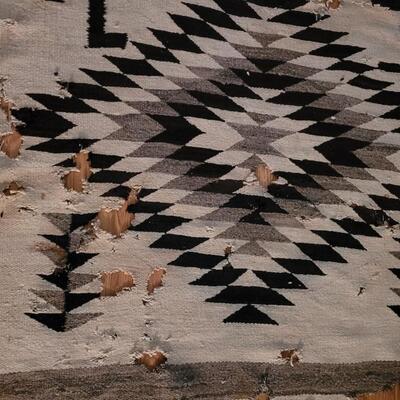
76.5" × 53" Has damage throughout but still has a lot of life left. Excerpt about the Whirling Log: The swastika motif goes back thousands of years in human culture. One of the oldest symbols made by humans, the swastika dates back some 6,000 years to rock and cave paintings. Scholars generally agree it originated in India. In the Navajo culture the swastika or Whirling Log, represents well being, good luck and protection. It comes from tale of the Whirling Log. The Whirling Log The hero of the story sets out on a long journey. At first the gods try to persuade him against going, but seeing his determination, help him hollow out a log in which he will travel down the river. Along the way he has many misadventures which ultimately result in his gaining important ceremonial knowledge. In one such instance he and his craft are captured by the Water People who carry him down beneath the waters to the home of Water Monster. Black God threatens to set fire to Water Monster's home and the hero is released, but not before being taught by Frog how to cure the illnesses caused by the Water People. When he finally reaches the lake that is his destination, the gods catch his log and help him to shore. Wandering about on land the hero comes upon a whirling cross with two yeis seated on each end. From them he learns the knowledge of farming and is given seeds. He then returns home to share these gifts with his people. Until the late 1800s, when J. Lorenzo Hubbell and J.B. Moore opened their trading posts in Arizona and New Mexico, Navajos portrayed the swastika solely in their religious ceremonies in the form of sand paintings. But by 1896, with prodding by Hubbell and Moore, the symbol proliferated on Navajo rugs. In 1940, in response to Hitler's regime, the Navajo, Papago, Apache and Hopi people signed a whirling log proclamation. It read, "Because the above ornament, which has been a symbol of friendship among our forefathers for many centuries, has been desecrated recently by another nation of peoples, therefore it is resolved that henceforth from this date on and forever more our tribes renounce the use of the emblem commonly known today as the swastika . . . on our blankets, baskets, art objects, sand paintings and clothing." 1375 / 2223 -
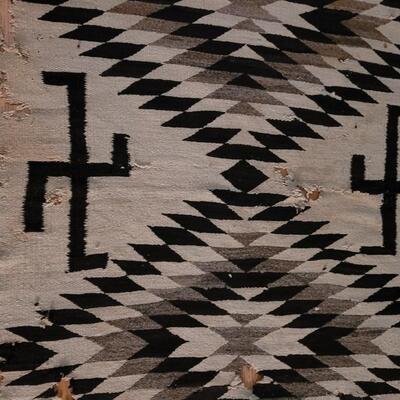
76.5" × 53" Has damage throughout but still has a lot of life left. Excerpt about the Whirling Log: The swastika motif goes back thousands of years in human culture. One of the oldest symbols made by humans, the swastika dates back some 6,000 years to rock and cave paintings. Scholars generally agree it originated in India. In the Navajo culture the swastika or Whirling Log, represents well being, good luck and protection. It comes from tale of the Whirling Log. The Whirling Log The hero of the story sets out on a long journey. At first the gods try to persuade him against going, but seeing his determination, help him hollow out a log in which he will travel down the river. Along the way he has many misadventures which ultimately result in his gaining important ceremonial knowledge. In one such instance he and his craft are captured by the Water People who carry him down beneath the waters to the home of Water Monster. Black God threatens to set fire to Water Monster's home and the hero is released, but not before being taught by Frog how to cure the illnesses caused by the Water People. When he finally reaches the lake that is his destination, the gods catch his log and help him to shore. Wandering about on land the hero comes upon a whirling cross with two yeis seated on each end. From them he learns the knowledge of farming and is given seeds. He then returns home to share these gifts with his people. Until the late 1800s, when J. Lorenzo Hubbell and J.B. Moore opened their trading posts in Arizona and New Mexico, Navajos portrayed the swastika solely in their religious ceremonies in the form of sand paintings. But by 1896, with prodding by Hubbell and Moore, the symbol proliferated on Navajo rugs. In 1940, in response to Hitler's regime, the Navajo, Papago, Apache and Hopi people signed a whirling log proclamation. It read, "Because the above ornament, which has been a symbol of friendship among our forefathers for many centuries, has been desecrated recently by another nation of peoples, therefore it is resolved that henceforth from this date on and forever more our tribes renounce the use of the emblem commonly known today as the swastika . . . on our blankets, baskets, art objects, sand paintings and clothing." 1376 / 2223 -

76.5" × 53" Has damage throughout but still has a lot of life left. Excerpt about the Whirling Log: The swastika motif goes back thousands of years in human culture. One of the oldest symbols made by humans, the swastika dates back some 6,000 years to rock and cave paintings. Scholars generally agree it originated in India. In the Navajo culture the swastika or Whirling Log, represents well being, good luck and protection. It comes from tale of the Whirling Log. The Whirling Log The hero of the story sets out on a long journey. At first the gods try to persuade him against going, but seeing his determination, help him hollow out a log in which he will travel down the river. Along the way he has many misadventures which ultimately result in his gaining important ceremonial knowledge. In one such instance he and his craft are captured by the Water People who carry him down beneath the waters to the home of Water Monster. Black God threatens to set fire to Water Monster's home and the hero is released, but not before being taught by Frog how to cure the illnesses caused by the Water People. When he finally reaches the lake that is his destination, the gods catch his log and help him to shore. Wandering about on land the hero comes upon a whirling cross with two yeis seated on each end. From them he learns the knowledge of farming and is given seeds. He then returns home to share these gifts with his people. Until the late 1800s, when J. Lorenzo Hubbell and J.B. Moore opened their trading posts in Arizona and New Mexico, Navajos portrayed the swastika solely in their religious ceremonies in the form of sand paintings. But by 1896, with prodding by Hubbell and Moore, the symbol proliferated on Navajo rugs. In 1940, in response to Hitler's regime, the Navajo, Papago, Apache and Hopi people signed a whirling log proclamation. It read, "Because the above ornament, which has been a symbol of friendship among our forefathers for many centuries, has been desecrated recently by another nation of peoples, therefore it is resolved that henceforth from this date on and forever more our tribes renounce the use of the emblem commonly known today as the swastika . . . on our blankets, baskets, art objects, sand paintings and clothing." 1377 / 2223 -
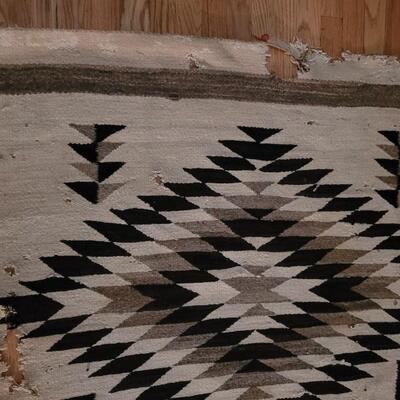
76.5" × 53" Has damage throughout but still has a lot of life left. Excerpt about the Whirling Log: The swastika motif goes back thousands of years in human culture. One of the oldest symbols made by humans, the swastika dates back some 6,000 years to rock and cave paintings. Scholars generally agree it originated in India. In the Navajo culture the swastika or Whirling Log, represents well being, good luck and protection. It comes from tale of the Whirling Log. The Whirling Log The hero of the story sets out on a long journey. At first the gods try to persuade him against going, but seeing his determination, help him hollow out a log in which he will travel down the river. Along the way he has many misadventures which ultimately result in his gaining important ceremonial knowledge. In one such instance he and his craft are captured by the Water People who carry him down beneath the waters to the home of Water Monster. Black God threatens to set fire to Water Monster's home and the hero is released, but not before being taught by Frog how to cure the illnesses caused by the Water People. When he finally reaches the lake that is his destination, the gods catch his log and help him to shore. Wandering about on land the hero comes upon a whirling cross with two yeis seated on each end. From them he learns the knowledge of farming and is given seeds. He then returns home to share these gifts with his people. Until the late 1800s, when J. Lorenzo Hubbell and J.B. Moore opened their trading posts in Arizona and New Mexico, Navajos portrayed the swastika solely in their religious ceremonies in the form of sand paintings. But by 1896, with prodding by Hubbell and Moore, the symbol proliferated on Navajo rugs. In 1940, in response to Hitler's regime, the Navajo, Papago, Apache and Hopi people signed a whirling log proclamation. It read, "Because the above ornament, which has been a symbol of friendship among our forefathers for many centuries, has been desecrated recently by another nation of peoples, therefore it is resolved that henceforth from this date on and forever more our tribes renounce the use of the emblem commonly known today as the swastika . . . on our blankets, baskets, art objects, sand paintings and clothing." 1378 / 2223 -

76.5" × 53" Has damage throughout but still has a lot of life left. Excerpt about the Whirling Log: The swastika motif goes back thousands of years in human culture. One of the oldest symbols made by humans, the swastika dates back some 6,000 years to rock and cave paintings. Scholars generally agree it originated in India. In the Navajo culture the swastika or Whirling Log, represents well being, good luck and protection. It comes from tale of the Whirling Log. The Whirling Log The hero of the story sets out on a long journey. At first the gods try to persuade him against going, but seeing his determination, help him hollow out a log in which he will travel down the river. Along the way he has many misadventures which ultimately result in his gaining important ceremonial knowledge. In one such instance he and his craft are captured by the Water People who carry him down beneath the waters to the home of Water Monster. Black God threatens to set fire to Water Monster's home and the hero is released, but not before being taught by Frog how to cure the illnesses caused by the Water People. When he finally reaches the lake that is his destination, the gods catch his log and help him to shore. Wandering about on land the hero comes upon a whirling cross with two yeis seated on each end. From them he learns the knowledge of farming and is given seeds. He then returns home to share these gifts with his people. Until the late 1800s, when J. Lorenzo Hubbell and J.B. Moore opened their trading posts in Arizona and New Mexico, Navajos portrayed the swastika solely in their religious ceremonies in the form of sand paintings. But by 1896, with prodding by Hubbell and Moore, the symbol proliferated on Navajo rugs. In 1940, in response to Hitler's regime, the Navajo, Papago, Apache and Hopi people signed a whirling log proclamation. It read, "Because the above ornament, which has been a symbol of friendship among our forefathers for many centuries, has been desecrated recently by another nation of peoples, therefore it is resolved that henceforth from this date on and forever more our tribes renounce the use of the emblem commonly known today as the swastika . . . on our blankets, baskets, art objects, sand paintings and clothing." 1379 / 2223 -
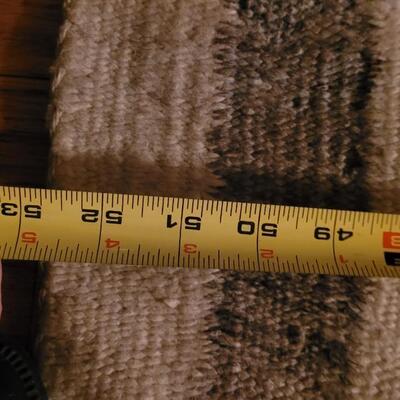
76.5" × 53" Has damage throughout but still has a lot of life left. Excerpt about the Whirling Log: The swastika motif goes back thousands of years in human culture. One of the oldest symbols made by humans, the swastika dates back some 6,000 years to rock and cave paintings. Scholars generally agree it originated in India. In the Navajo culture the swastika or Whirling Log, represents well being, good luck and protection. It comes from tale of the Whirling Log. The Whirling Log The hero of the story sets out on a long journey. At first the gods try to persuade him against going, but seeing his determination, help him hollow out a log in which he will travel down the river. Along the way he has many misadventures which ultimately result in his gaining important ceremonial knowledge. In one such instance he and his craft are captured by the Water People who carry him down beneath the waters to the home of Water Monster. Black God threatens to set fire to Water Monster's home and the hero is released, but not before being taught by Frog how to cure the illnesses caused by the Water People. When he finally reaches the lake that is his destination, the gods catch his log and help him to shore. Wandering about on land the hero comes upon a whirling cross with two yeis seated on each end. From them he learns the knowledge of farming and is given seeds. He then returns home to share these gifts with his people. Until the late 1800s, when J. Lorenzo Hubbell and J.B. Moore opened their trading posts in Arizona and New Mexico, Navajos portrayed the swastika solely in their religious ceremonies in the form of sand paintings. But by 1896, with prodding by Hubbell and Moore, the symbol proliferated on Navajo rugs. In 1940, in response to Hitler's regime, the Navajo, Papago, Apache and Hopi people signed a whirling log proclamation. It read, "Because the above ornament, which has been a symbol of friendship among our forefathers for many centuries, has been desecrated recently by another nation of peoples, therefore it is resolved that henceforth from this date on and forever more our tribes renounce the use of the emblem commonly known today as the swastika . . . on our blankets, baskets, art objects, sand paintings and clothing." 1380 / 2223 -

76.5" × 53" Has damage throughout but still has a lot of life left. Excerpt about the Whirling Log: The swastika motif goes back thousands of years in human culture. One of the oldest symbols made by humans, the swastika dates back some 6,000 years to rock and cave paintings. Scholars generally agree it originated in India. In the Navajo culture the swastika or Whirling Log, represents well being, good luck and protection. It comes from tale of the Whirling Log. The Whirling Log The hero of the story sets out on a long journey. At first the gods try to persuade him against going, but seeing his determination, help him hollow out a log in which he will travel down the river. Along the way he has many misadventures which ultimately result in his gaining important ceremonial knowledge. In one such instance he and his craft are captured by the Water People who carry him down beneath the waters to the home of Water Monster. Black God threatens to set fire to Water Monster's home and the hero is released, but not before being taught by Frog how to cure the illnesses caused by the Water People. When he finally reaches the lake that is his destination, the gods catch his log and help him to shore. Wandering about on land the hero comes upon a whirling cross with two yeis seated on each end. From them he learns the knowledge of farming and is given seeds. He then returns home to share these gifts with his people. Until the late 1800s, when J. Lorenzo Hubbell and J.B. Moore opened their trading posts in Arizona and New Mexico, Navajos portrayed the swastika solely in their religious ceremonies in the form of sand paintings. But by 1896, with prodding by Hubbell and Moore, the symbol proliferated on Navajo rugs. In 1940, in response to Hitler's regime, the Navajo, Papago, Apache and Hopi people signed a whirling log proclamation. It read, "Because the above ornament, which has been a symbol of friendship among our forefathers for many centuries, has been desecrated recently by another nation of peoples, therefore it is resolved that henceforth from this date on and forever more our tribes renounce the use of the emblem commonly known today as the swastika . . . on our blankets, baskets, art objects, sand paintings and clothing." 1381 / 2223
Photos 1301 - 1400 of 2223
Per page:
